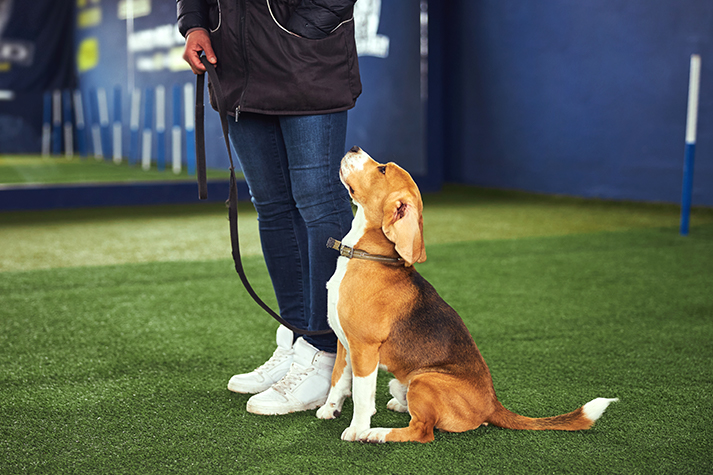
23 Oct
What is Pet Training? Why is it Important?
Pets are little bundles of joy, brightening our lives immensely. However, for them to be comfortable inside the house and out in the world, they require pet training. People assume training a pet is a huge and arduous task, one that can only be accomplished with professional assistance, or that only works with certain breeds. To help burst this bubble, we will discuss how anybody can train their pet in the comfort of their home with relatively little time required. To learn how to train your pet, it's important to understand why we train our pets in the first place.
Here Are Some Benefits of Pet Training:
Better Communication and Trust
Pet training helps an owner establish a line of communication between themselves and their pet, as it gives them the tools to get their pet to perform a desired behaviour and teaches the pet how to respond correctly. Adding pet training to your pet’s daily schedule acts as a bonding experience unlike any other. Your pet will learn to look up to you as their leader and will begin to trust and respect your guidance.
Unmanaged behaviours, leash pulling for instance, that are left unchecked eventually continue and worsen over time. An untrained adult pet can display behavioural issues simply because they were never shown the right way to behave. Pets don't instinctively understand what we want from them or how to live in our world, but given the right structure, they can learn how to do so and thrive.
Life Skills Education
One of the most important stages for any pet is potty training. Some new pet owners encounter a problem with this stage, as they don’t realize that their pet does not understand where they can and cannot relieve themselves, not to mention how many times they need to go per day and be shown their designated area.
Toilet training is an essential life skill, but it isn’t the only one pet training provides. Additionally, crate training teaches your pet to remain confident when alone and helps speed up the toilet training process. Crate training will also be useful later on during pet travel, as pets usually have to spend the duration of a journey inside their IATA approved pet crate. Pet training also provides some semblance of structure in the form of daily schedules and boundaries to help your pet understand what’s expected of them.
When we mention boundaries for a pet, what we essentially mean is giving your pet the rules of conduct when it comes to being inside your home and in public. They are the dos and don’ts of your pet, like how to greet someone when on a walk, or where they are and aren’t allowed to sit in the house. Establishing boundaries will help facilitate good manners in all aspects of your pet’s life.
Stress Buster
Pet training can help alleviate your pet's stress across the board, from anxiety due to being in a new location to meeting and interacting with new people and pets. Socializing a pet to new environments and experiences is a large part of pet training. Once your pet is cleared by their vet and receives all their vaccinations, try socializing them as much as possible, as the mark of a well-trained pet is one who is comfortable in social situations and feels comfortable and confident meeting new people and pets. Training is also extremely helpful during pet travel, as it will help your pet stay relaxed and be better-equipped to deal with any potential stressors.
Keeps Your Pets Safe
As a pet owner, nothing is more important than your pet's safety. Pet training provides you with the skills to communicate with your pet and is particularly important when it comes to giving your pet a command in various environments and situations, including local and international pet travel.
Knowing basic obedience commands, especially when outdoors and off-leash, can protect your pet from confrontations with other pets and wildlife. Nothing is scarier than the moment your leash slips through your fingers and your pet goes running towards a busy street. Fortunately, if you train your pet to have a strong recall from distance, the moment you command them to “come”, they’ll head right back to you, away from danger.
Methods of Pet Training
There are two common methods of training a pet:
The first is the aversive-based method. The second is the reward-based method. Aversive-based (discipline) training is when you use positive punishment and negative reinforcement techniques with your pet. Reward-based methods use rewards only for the behaviours that you want your pet to follow.
Aversive-based training uses techniques like loud, unpleasant noises, physical corrections, and harsh scoldings to get your pet to act the way you want. On the other hand, reward-based training uses rewards whenever your pet does something you want it to do. Treats, belly rubs, or other pet-pleasing actions are used to reinforce that behaviour was good.
First, you need to understand your pet's psychology and intelligence quotient.
There are three types of pet intelligence recognized by scientists:
- Instinctive
- Adaptive
- Working and obedience
Instinctive learning is when your pet learns the behaviours they were bred for. Adaptive learning is how well your pet learns from their surroundings and the environment around them to solve problems. Working and obedience are how well they learn the tasks and commands that you teach them.
Rewards for Obedience Training
Whenever you utilize reward-based preparation, your pet needs to understand that there and consequences for behaving in a manner that you do not approve of.
For example, a pet that likes to hop up to welcome people when they come home can be risky if an elderly person or a child is visiting. To teach them otherwise, don't welcome or accommodate them when they hop up. Instead, simply pivot and back out the door, and repeat until the pet stops hopping up as a greeting. Keep a treat in hand as you do this process.
Whenever the pet doesn’t hop up, give them the treat, and rehash the process until your pet no longer demonstrates this behaviour when you come in. You ought to attempt this with each individual that your pet gets excited to see when they come into your house. Make sure they give your pet the treat when they follow the right way of behaving.
What Is the Correct Age to Start Training Your Pet?
People often get confused as to when and at what age should they start training their pets. Some believe that a pet should be mature enough to understand what its owner is saying, while others believe that pet training should begin from a young age. The answer is fairly simple; basic training, which includes following basic commands such as sit, stand, roll, walk, run, bark, etc. should begin at an early age of 3-4 months. This ensures a proper foundation is laid by you and is beneficial when it is time to teach them advanced and more complex commands.






AUTHOR’S BIO
Carry My Pet
Passionate pet enthusiasts and globetrotters, dedicated to easing furry friends' journeys worldwide. Penning tales of compassion at CarryMyPet, where every relocation is a tail-wagging adventure.